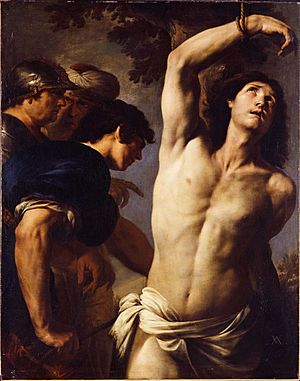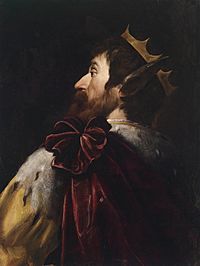Andrea Vaccaro facts for kids
Andrea Vaccaro (born May 8, 1604 – died January 18, 1670) was an Italian painter from the Baroque period. He was one of the most successful artists in Naples, a city that was under Spanish rule at the time. Vaccaro and his art workshop created many religious paintings. These works were for people in Naples and also sent to religious groups and important families in Spain. At first, he was inspired by the artist Caravaggio, especially in how he used light and shadow (called chiaroscuro) and made his figures look very real.
Life of Andrea Vaccaro
We don't know much about Andrea Vaccaro's early life for sure. He was born in Naples. His father, Pietro Baccaro, was a lawyer. Andrea first studied books and writing before he decided to become an artist. It was once thought he learned from a painter named Girolamo Imparato. However, Imparato died in 1607, so he couldn't have been Vaccaro's teacher. Instead, when Andrea Vaccaro was 16, he became a student of a less famous artist named Giovanni Tommaso Passaro. None of the paintings from this early time in his career still exist today.
Andrea Vaccaro had a child, Angela Geronima, with his first wife in 1628. This shows he had already started a family by then. We don't have more details about this first marriage.
His paintings from after 1620 show the influence of Caravaggio and other artists in Naples who followed Caravaggio's style. It's said that Vaccaro painted a copy of Caravaggio's famous painting Flagellation. For a time, both the copy and the original hung together in a church called San Domenico Maggiore. Some experts aren't sure if Vaccaro truly painted this copy. After 1630, Vaccaro saw the works of other famous artists like Guido Reni, Anthony van Dyck, and Pietro Novelli. He made copies of their paintings for art collectors in Naples and for art dealers from Flanders, like Gaspar Roomer. It's thought that he also bought and sold art himself, which was common for painters in Naples back then.
Vaccaro married his second wife, Anna Criscuolo, in 1639. She was 24 years old. A year later, in 1640, their son Tomaso Domenico Nicola was born. This son later became a painter known as Nicola Vaccaro.
Andrea Vaccaro became very successful. Almost every art collection in Naples had at least one of his paintings. He also had people who bought his art in other parts of Italy. From 1635, he started sending religious paintings to Spain. These were for religious groups and important families there. The Spanish Viceroy of Naples, Gaspar de Bracamonte, 3rd Count of Peñaranda, also supported him. The Viceroy asked Vaccaro to paint the main altar for the Santa Maria del Pianto, Naples church.
In 1656, a terrible sickness spread through Naples, causing many people to die. This included artists like Bernardo Cavallino and Massimo Stanzione, who were close to Andrea Vaccaro. Despite this, Vaccaro continued to get many requests for paintings. He even received a special request to paint frescoes (wall paintings) in the Theatine church of San Paolo Maggiore in Naples. This was the only time in his career he painted frescoes.
In 1665, Vaccaro helped start and lead a group called the 'Congrega dei SS Anna e Luca'. This was like a guild for painters, probably aiming to improve the standing of artists in Naples. Between 1650 and 1670, Vaccaro's art had a big impact on painting in Naples. His style was very important, along with that of Massimo Stanzione and the young Luca Giordano, who was just starting his career.
Later in his life, Andrea Vaccaro was also involved in a group called the 'Confraternita dei Bianchi'. He was also a Governatore (a kind of leader) for the 'Conservatorium and Church of Pietà dei Turchini'. His students included Giacomo Farelli and Giuseppe Fattoruso.
Andrea Vaccaro's Artworks
Only two paintings by Andrea Vaccaro are known to have his full signature. These are Saint Teresa’s Vision of the Golden Collar (in Madrid) and Saint Luke Portraying the Virgin and Child. These signed paintings also show the year they were made. Only one other painting, the Communion of Saint Mary of Egypt, shows the year.
Vaccaro often used his special symbol, called a monogram, on his paintings. It's made of his initials, A and V, linked together. The left part of the A goes over the left part of the V, and the right parts do the same. The middle of the letters forms a diamond shape because the crossbar of the A is missing. Sometimes, small triangles appear on both sides of the monogram.
It has been hard to know for sure which paintings are truly by Vaccaro. This is because we don't fully understand how his painting style changed over time. Also, he had a large workshop where assistants helped him or made copies of his works. This makes it tricky to tell which paintings are truly his.
At first, Vaccaro was inspired by Caravaggio. He used strong contrasts between light and dark (called chiaroscuro) and made his figures look very natural. From 1630 onwards, he also got ideas from artists like Guido Reni, Anthony van Dyck, and Pietro Novelli. His use of dark shadows became softer and brighter, influenced by artists like Pietro da Cortona. The elegant style of Bernardo Cavallino, whom Vaccaro met and worked with in the 1640s, also became an influence.
Vaccaro always kept up with the newest art trends. His later works show the bright colors of Luca Giordano and the way Mattia Preti played with light and shadow. Because he was so successful, many of his paintings were sent to Spain. A large number of his works are still found there today.
See also
 In Spanish: Andrea Vaccaro para niños
In Spanish: Andrea Vaccaro para niños




